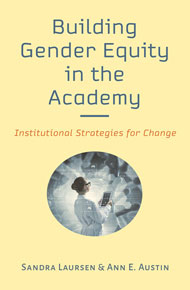Research shows women are persistently underrepresented in the academic disciplines of science, technology, engineering and math, commonly known as STEM, particularly in positions of leadership. This is often caused by barriers built into the academic workplace, though researchers argue this can be corrected through deliberate, systemic change.
In their new book, “Building Gender Equity in the Academy: Institutional Strategies for Change,” scholars Ann Austin and Sandra Laursen detail strategies for universities wishing to foster a more diverse, equitable environment.

Austin, a University Distinguished Professor in the Higher, Adult and Lifelong Education program at Michigan State University, has spent many years researching issues surrounding the academic workplace, faculty careers and organizational change in higher education. She has studied methods of creating equitable and inclusive work environments, particularly in the STEM disciplines but also applicable across a higher education institution and relevant to creating a more inclusive organization for all.
“Excellence and high-quality work absolutely depend on equity and diversity,” says Austin. “We need diverse points of view, backgrounds and experiences.”
Efforts to accomplish exactly this have been a long time coming. In 2001, the National Science Foundation (NSF) developed its ADVANCE program, focused on increasing the representation and advancement of women in academic STEM disciplines. According to its website, NSF has invested more than $135 million to support ADVANCE projects at more than 100 different higher ed institutions since its inception 20 years ago. And while its initial focus was gender equity, the program has expanded to support members of all underrepresented groups, its focus now including gender, race, ethnicity and persons with disabilities.

“Building Gender Equity in the Academy” focuses on the strategies and interventions for institutional transformation used at universities that received ADVANCE funding for such endeavors. The authors studied various ways to use these strategies and how to combine them to create powerful institutional change processes.
“We began to realize there was a need to do some research on what was being learned about how to go about actually creating organizational change,” says Austin, who also serves as associate dean for research in the MSU College of Education. “What are we learning as universities try to engage in this work?”
With this question in mind, Austin and Laursen, a senior research associate and director of ethnography and evaluation research at the University of Colorado Boulder, applied for their own NSF grants to begin researching universities that had been funded to work on building more inclusive environments. The two studied nearly 30 institutions of higher education through interviews, institutional document reviews, case studies and campus visits.
From their research, Austin and Laursen identified specific barriers built into the academic workplace affecting women: implicit bias (particularly around gender and race) in selection and promotion systems, the historic culture of the workplace in the U.S. that has generally been more supportive of men, and general stereotypes in society around gender and ability in the STEM field.
“Building Gender Equity in the Academy” addresses these barriers by analyzing strategies used to create more inclusive work environments and offers a concrete approach to creating institutions that foster gender equity, highlighting the need for a systemic approach.
“In the book, we identified 12 strategies for organizational change that address and advance more inclusive workplaces,” Austin says. “The underlying philosophy that guided us is the idea that diversity isn’t a ‘nice to have’—it’s absolutely essential in higher education.”
Austin explains the book organizes those 12 strategies into four categories, each supported by practical examples of how to implement real change. She also stresses the importance of context.
“It’s necessary to analyze the context of an organization. What’s the nature of the problem? If we want more diversity, we need to figure out the specific barriers,” she says.
When the context of an institution’s environment is considered, it can help in creating systemic change.
“It’s important to take a systemic approach,” Austin says. “Look at the structure of the organization and figure out the levers for change. What can change that creates an environment to address the barriers?”
To achieve systemic reform within institutions, the people within those institutions must understand how to create a portfolio of strategic change strategies, which is exactly what Austin hopes “Building Gender Equity in the Academy” will help accomplish.
“Our big hope is to support universities,” she says. “Excellence requires diversity, but it requires a systemic approach.”
The American Association for the Advancement of Science (AAAS) recently contacted Austin and Laursen about conducting four webinars highlighting the book that will be promoted to a national audience. More information about the webinars, which begin in February, can be found here.
“Building Gender Equity in the Academy” can be purchased from John Hopkins University Press.
Written by Ilene Davis
Related news
Austin and Laursen spoke to Inside Higher Ed about their new book. Read the Q&A.
Austin previously received three grants totaling $2.7 million from the National Science Foundation to study how reforms to institutional policies and practices, along with teaching and curriculum, can be leveraged to help undergraduates succeed in science, technology, engineering and mathematics, or STEM.




